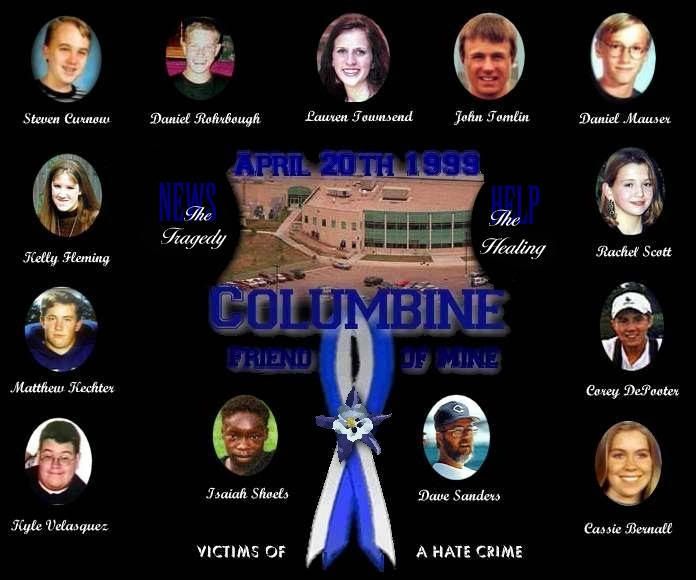

Mass Shooting Reopens Wounds, Columbine Survivor Says
http://history1900s.about.com/od/famouscrimesscandals/a/columbine.htm
On April 20, 1999, in the small, suburban town of Littleton, Colorado, two high-school seniors, Dylan Klebold and Eric Harris, enacted an all-out assault on Columbine High School during the middle of the school day. The boys' plan was to kill hundreds of their peers. With guns, knives, and a multitude of bombs, the two boys walked the hallways and killed. When the day was done, twelve students, one teacher, and the two murderers were dead. The haunting question remains: why did they do it?
The Boys: Dylan Klebold and Eric Harris
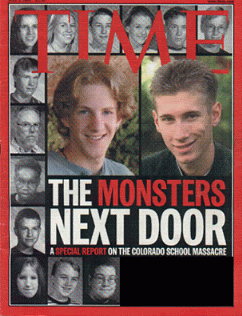
Dylan Klebold and Eric Harris were both intelligent, came from solid homes with two parents, and had older brothers who were three years their senior. In elementary school, Klebold and Harris had both played in sports such as baseball and soccer. Both enjoyed working with computers.
The boys met each other while attending Ken Caryl Middle School in 1993. Though Klebold had been born and raised in the Denver area, Harris' father had been in the U.S. Air Force and had moved the family several times before he retired and moved his family to Littleton, Colorado in July 1993. When the two boys entered high school, they found it difficult to fit into any of the cliques.* As is too common in high school, the boys found themselves frequently picked on by athletes and other students.
However, Klebold and Harris seemed to spend their time doing normal teenager activities. They worked together in a local pizza parlor, liked to play Doom (a computer game) in the afternoons, and worried about finding a date to the prom. For all outward appearances, the boys looked like normal teenagers. Looking back, Dylan Klebold and Eric Harris obviously weren't your average teenagers.
Preparations
According to journals, notes, and videos that Klebold and Harris left to be discovered, Klebold had been thinking of committing suicide as early as 1997 and they both had begun thinking about a large massacre as early as April 1998 - a full year before the actual event.
By then, the two had already run into some trouble. On January 30, 1998, Klebold and Harris were arrested for breaking into a van. As part of their plea agreement, the two began a juvenile diversion program in April 1998. Since they were first-time offenders, this program allowed them to purge the event from their record if they could successfully complete the program. So, for eleven months, the two attended workshops, spoke to counselors, worked on volunteer projects, and convinced everyone that they were sincerely sorry about the break-in. However, during the entire time, Klebold and Harris were making plans for a large-scale massacre at their high school.
Klebold and Harris were angry teenagers. They were not only angry at athletes that made fun of them, or Christians, or blacks, as some people have reported; they basically hated everyone except for a handful of people. On the front page of Harris's journal, he wrote: "I hate the fucking world." Harris also wrote that he hates racists, martial arts experts, and people who brag about their cars. He stated:
You know what I hate? Star Wars fans: get a friggin life, you boring geeks. You know what I hate? People who mispronounce words, like 'acrost,' and 'pacific' for 'specific,' and 'expresso' instead of 'espresso.' You know what I hate? People who drive slow in the fast lane, God these people do not know how to drive. You know what I hate? The WB network!!!! Oh Jesus, Mary Mother of God Almighty, I hate that channel with all my heart and soul."1 Both Klebold and Harris were serious about acting out on this hate. As early as spring 1998, they wrote about killing and retaliation in each other's yearbooks, including an image of a man standing with a gun, surrounded by dead bodies, with the caption, "The only reason your [sic] still alive is because someone has decided to let you live."2
Klebold and Harris used the Internet to find recipes for pipe bombs and other explosives. They amassed an arsenal, which eventually included guns, knives, and 99 explosive devices.
Klebold and Harris wanted to kill as many people as possible, so they studied the influx of students in the cafeteria, noting that there would be over 500 students after 11:15 a.m. when the first lunch period began. They planned to plant propane bombs in the cafeteria timed to explode at 11:17 and then shoot any survivors as they came running out.
There is some discrepancy whether the original date planned for the massacre was to be April 19 or 20. April 19 was the anniversary for the Oklahoma City Bombing and April 20 was the 110th anniversary of Adolf Hitler's birthday. For whatever reason, April 20 was the date finally chosen.
* Though some claimed they were part of the Trench Coat Mafia, in truth, they were only friends with some of the group's members. The boys didn't usually wear trench coats to school; they did so only on April 20 to hide the weapons they were carrying as they walked across the parking lot.
At 11:10 a.m. on Tuesday, April 20, 1999, Dylan Klebold and Eric Harris arrived at Columbine High School. Each drove separately and parked in spots in the junior and senior parking lots, flanking the cafeteria. Around 11:14, the boys carried two 20-pound propane bombs (with timers set for 11:17) in duffel bags and placed them near tables in the cafeteria. No one noticed them place the bags; the bags blended in with the hundreds of school bags that the other students had brought with them to lunch. The boys then went back to their cars to wait for the explosion.
Nothing happened. (It is believed that if the bombs had exploded, it is probable that all 488 students in the cafeteria would have been killed.)
The boys waited a few extra minutes for the cafeteria bombs to explode, but still nothing happened. They realized that something must have gone wrong with the timers. Their original plan had failed, but the boys decided to go into the school anyway.
Klebold, wearing cargo pants and a black T-shirt with "Wrath" on the front, was armed with a 9-mm semi-automatic handgun and a 12-gauge double-barrel sawed-off shotgun. Harris, wearing dark-colored pants and a white T-shirt that said "Natural Selection," was armed with a 9-mm carbine rifle and a 12-gauge pump sawed-off shotgun. Both wore black trench coats to hide the weapons they were carrying and utility belts filled with ammunition. Klebold wore a black glove on his left hand; Harris wore a black glove on his right hand. They also carried knives and had a backpack and a duffel bag full of bombs.
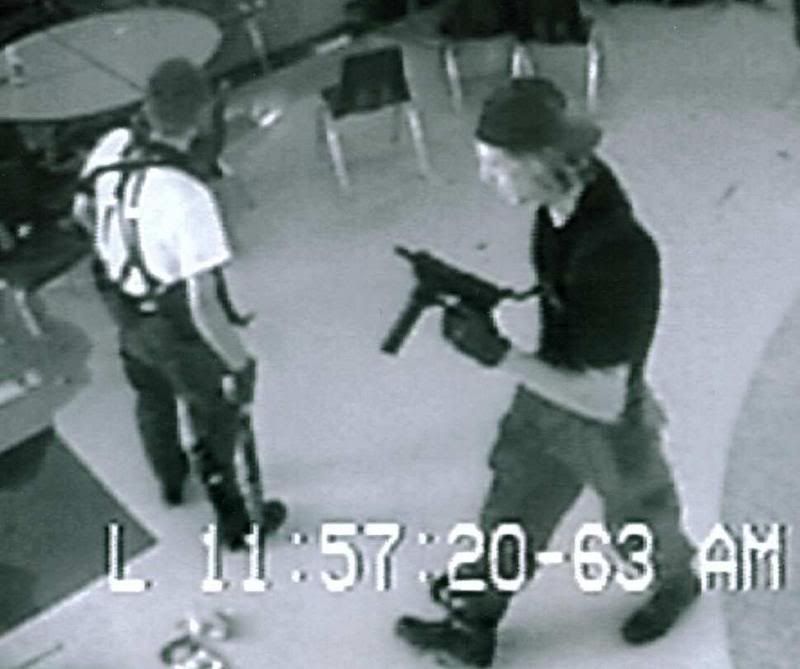
At 11:19, the two pipe bombs that Klebold and Harris had set up in an open field several blocks away exploded; they timed the explosion so that it would be a distraction for police officers.
At the same time, Klebold and Harris started firing their first shots at students sitting outside the cafeteria. Almost immediately, 17-year old Rachel Scott was killed and Richard Castaldo was injured. Harris took off his trench coat and both boys kept firing.
Unfortunately, many of the other students didn't realize yet what was happening. It was only a few weeks until graduation for the seniors and as is tradition among many U.S. schools, seniors often pull a "senior prank" before they leave. Many of the students believed that the shootings were just a joke - part of a senior prank - so they didn't immediately flee the area.
Students Sean Graves, Lance Kirklin and Daniel Rohrbough were just leaving the cafeteria when they saw Klebold and Harris with guns. Unfortunately, they thought the guns were paint ball guns and part of the senior prank. So the three kept walking, heading toward Klebold and Harris. All three are wounded.
Klebold and Harris swiveled their guns to the right and then shot at five students who were eating lunch in the grass. At least two were hit - one was able to run to safety while the other was too debilitated to leave the area.
As Klebold and Harris walked, they nearly continually threw small bombs into the area.
Klebold then walked down the stairs, toward the injured Graves, Kirklin and Rohrbough. At close range, Klebold shot Rohrbough and then Kirklin. Rohrbough died instantly; Kirklin survived his wounds. Graves had managed to crawl back down to the cafeteria, but lost strength in the doorway. He pretended to be dead and Klebold walked over him to peer into the cafeteria.
The students in the cafeteria started looking out the windows once they heard gunfire and explosions, but they too thought it was either a senior prank or a film being made. A teacher, William "Dave" Sanders, and two custodians realized that this was not just a senior prank and that there was real danger. They tried to get all the students away from the windows and to get down on the floor. Many of the students evacuated the room by going up the stairs to the second level of the school. Thus, when Klebold peered into the cafeteria, it looked empty.
While Klebold was looking into the cafeteria, Harris continued shooting outside. He hit Anne Marie Hochhalter as she was getting up to flee.
With Harris and Klebold were back together, they turned to enter the school through the west doors, firing as they went. A policeman arrived on the scene and exchanged fire with Harris, but neither Harris nor the policeman was injured. At 11:25, Harris and Klebold entered the school.
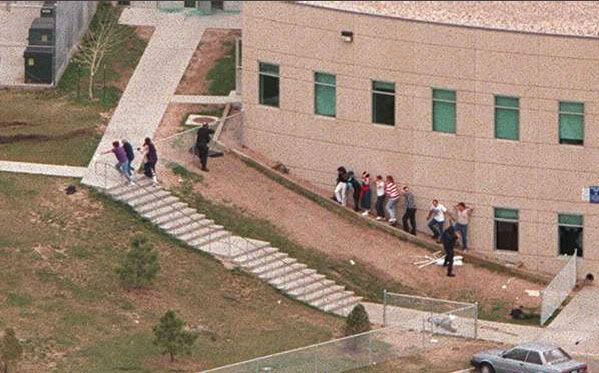
Inside the School
Harris and Klebold walked down the north hallway, shooting and laughing as they went. Most of the students not at lunch were still in class and didn't know what was going on. Stephanie Munson, one of several students walking down the hall, saw Harris and Klebold and tried to run out of the building. She was hit in the ankle but managed to make it to safety. Klebold and Harris then turned around and headed back down the hallway (toward the entrance they had gone through to enter the school).
Dave Sanders, the teacher who had directed students to safety in the cafeteria and elsewhere, was coming up the stairs and rounding a corner when he saw Klebold and Harris with guns raised. He quickly turned around and was about to turn a corner to safety when he was shot. Sanders managed to crawl to the corner and another teacher dragged Sanders into a classroom, where a group of students were already hiding. The students and the teacher spent the next few hours trying to keep Sanders alive.
Klebold and Harris spent the next three minutes indiscriminately shooting and throwing bombs in the hallway outside the library, where Sanders was shot. They threw two pipe bombs down the stairs into the cafeteria. Fifty-two students and four staff were hiding in the cafeteria and could hear the gunshots and explosions.
At 11:29, Klebold and Harris entered the library.
The Library
Klebold and Harris entered the library and shouted "Get up!" Then they asked for anyone wearing a white cap (jocks) to stand up. No one did. Klebold and Harris started firing; one student was injured from flying wood debris.
Walking through the library to the windows, Klebold shot and killed Kyle Velasquez, who was sitting at a computer desk rather than hiding under a table. Klebold and Harris set down their bags and started shooting out the windows toward policemen and escaping students. Klebold then took off his trench coat. One of the gunmen yelled "Yahoo!"
Klebold then turned and shot at three students hiding under a table, injuring all three. Harris turned and shot Steven Curnow and Kacey Reugsegger, killing Curnow. Harris then walked over to a table near him where two girls were hiding underneath. He banged two times on the top of the table and said, "Peek-a-boo!" Then he shot under the table, killing Cassie Bernall. The "kick" from the shot broke his nose.
Harris then asked Bree Pasquale, a student sitting on the floor, if she wanted to die. While pleading for her life, Harris was distracted when Klebold called him to another table because one of the students hiding underneath was black. Klebold grabbed Isaiah Shoels and started dragging him from under the table when Harris shot and killed Shoels. Then Klebold shot under the table and killed Michael Kechter.
Harris disappeared into the book stacks for a minute while Klebold went to the front of the library (near the entrance) and shot out a display cabinet. Then the two of them went on a shooting rampage in the library.
They walked by table after table, shooting non-stop. Injuring many, Klebold and Harris killed Lauren Townsend, John Tomlin, and Kelly Fleming.
Stopping to reload, Harris recognized someone hiding under the table. The student was an acquaintance of Klebold's. The student asked Klebold what he was doing. Klebold answered, "Oh, just killing people."3 Wondering if he too were going to be shot, the student asked Klebold if he was going to be killed. Klebold told the student to leave the library, which the student did.
Harris again shot under a table, injuring several and killing Daniel Mauser and Corey DePooter.
After randomly shooting off a couple more rounds, throwing a Molotov cocktail, taunting a few students, and throwing a chair, Klebold and Harris left the library. In the 7 1/2 minutes they were in the library, they had killed 10 people and injured 12 others. Thirty-four students escaped uninjured.
Back Into the Hall
Klebold and Harris spent about eight minutes walking down the halls, looking into the science classrooms, and making eye contact with some of the students, but they didn't try very hard to get into any of the rooms. Students stay huddled and hidden in many of the classrooms with the doors locked. But locks wouldn't have been much protection if the gunmen had really wanted to get in.
At 11:44, Klebold and Harris headed back downstairs and entered the cafeteria. Harris shot at one of the duffel bags they had placed earlier, trying to get the 20-pound propane bomb to explode, but it didn't. Klebold then went over to the same bag and began fiddling with it. Still there was no explosion. Klebold then stepped back and threw a bomb at the propane bomb. Only the thrown bomb exploded and it started a fire, which triggered the sprinkler system.
Klebold and Harris wandered around the school throwing bombs. They eventually went back to the cafeteria only to see that the propane bombs had not exploded and the sprinkler system had put out the fire. At exactly noon, the two went back upstairs.
They headed back to the library, where nearly all the uninjured students had escaped. Several of the staff remained hidden in cabinets and side rooms. From 12:02 to 12:05, Klebold and Harris shot out the windows toward the policemen and paramedics that were outside.
Sometime between 12:05 and 12:08, Klebold and Harris went to the south side of the library and shot themselves in the head, ending the Columbine massacre.
To the policemen, paramedics, family and friends waiting outside, the horror of what was happening unfolded slowly. With 2,000 students attending Columbine High School, no one saw the whole event clearly. Thus, reports from witnesses escaping the school were skewed and fragmentary.
Law enforcement personnel tried to rescue those injured outside but Klebold and Harris shot at them from the library. No one saw the two gunmen commit suicide so no one was sure it was over until police were able to clear the building.
Students that had escaped were sent via school bus over to Leawood Elementary School where they were interviewed by police and then put on a stage for parents to claim. As the day wore on, the parents that remained were those of the victims. Confirmation of those that had been killed did not come until a day later.
Because of the large number of bombs and explosives thrown by the gunmen, the SWAT and police could not immediately enter the building to evacuate the remaining students and faculty that were hiding inside. Some had to wait hours to be rescued. Patrick Ireland, who had been shot two times in the head by the gunmen in the library, attempted to escape at 2:38 p.m. out the library window - two stories up. He fell into the waiting arms of SWAT while T.V. cameras showed the scene across the country. (Miraculously, Ireland survived the ordeal.)
Dave Sanders, the teacher who had helped hundreds of students escape and who had been shot around 11:26 a.m., lay dying in the science room. The students in the room tried to provide first aid, were given instructions over the phone to give emergency aid, and placed signs in the windows to get an emergency crew inside quickly, but no one arrived. It wasn't until 2:47 p.m. when he was just taking his last breaths that SWAT reached his room.
In all, Klebold and Harris killed thirteen people (twelve students and one teacher). Between the two of them, they fired 188 rounds of ammunition (67 by Klebold and 121 by Harris). Of the 76 bombs that Klebold and Harris threw during their 47-minute siege on Columbine, 30 exploded and 46 did not explode. In addition, they had planted 13 bombs in their cars (12 in Klebold's and 1 in Harris') that did not explode and 8 bombs at home. Plus, of course, the two propane bombs they planted in the cafeteria that did not explode.
Who Is to Blame?
No one can say for sure why Klebold and Harris committed such a horrific crime. Many people have come up with theories including being picked on in school, violent video games (Doom), violent movies (Natural Born Killers), music, racism, Goth, problematic parents, depression, and more.
It is hard to pinpoint one trigger that started these two boys on a murderous rampage. They worked hard to fool all those around them for over a year. Surprisingly, about a month before the event, the Klebold family took a four-day road trip to the University of Arizona, where Dylan had been accepted for the following year. During the trip, the Klebold's didn't notice anything strange or unusual about Dylan. Counselors and others also didn't notice anything unusual.
Looking back, there were telltale hints and clues that something was seriously wrong. Videotapes, journals, guns and bombs in their rooms would have been easily found if the parents had looked. Harris had made a website with hateful epithets that could have been followed up on.
The Columbine Massacre changed the way society looked at children and at schools. Violence was no longer just an after-school, inner-city activity. It could happen anywhere.
School Shooting and Antidepressants Fox News
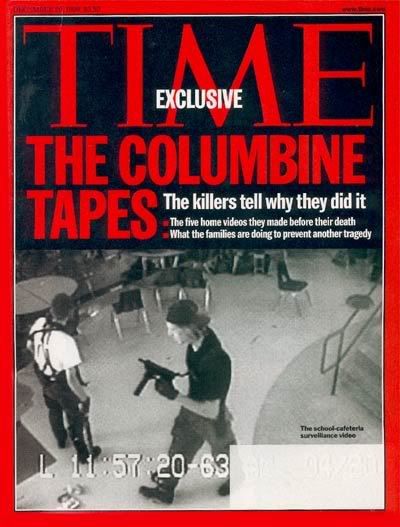
Columbine school to close on eighth anniversary of massacre
http://rawstory.com/news/afp/Columbine_school_to_close_on_eighth_04192007.ht
Columbine High School will close its doors to students on the eighth anniversary of the 1999 massacre on Friday, which comes just five days after the Virginia Tech tragedy.
A spokeswoman at Columbine said the school, in the Denver suburbs, had no special ceremonies planned to commemorate the 12 students and one teacher shot dead by Eric Harris and Dylan Klebold on April 20 eight years ago.
Instead, the school would be closed to students for a day of staff development, the spokeswoman said.
Survivors and the families of victims of Columbine have had painful memories reawakened this week following the gun rampage at Virginia Tech University on Monday by South Korean student Cho Seung-Hui that left 33 people dead.
Virginia police said that Cho was the likely killer of the first two students slain, but they still did not have definitive proof.
In a chilling tribute to Columbine killers Harris and Klebold, Cho even referred to "the martyrs Eric and Dylan" in his hate-filled multi-media manifesto sent to US broadcaster NBC.
Columbine High School principal Frank DeAngelis told local Colorado television station 9News that watching Monday's tragedy unfold on television had plunged him back into the horrors of April 20, 1999.
"It took me back ... feeling some of the emotions I felt that day," DeAngelis told the broadcaster. "First thing I felt was nausea. I just relived what happened at Columbine High School."
DeAngelis, who joined Columbine as a teacher 28 years ago, said television images of the Virginia Tech shooting were eerily similar to 1999.
"Even though it was in Virginia, I'm looking at Columbine High School. I see the students coming out of the building as our students," DeAngelis said.
Bill Biskup, a former music teacher at Columbine who has since relocated to Texas, said he had broken down while watching this week's reports.
"It tore me apart, I started crying at one point," said Biskup, who is bracing for an emotional remembrance of Columbine on Friday's anniversary.
"Friday will be tough for me, (April) 20th always is," he told local television stations in Houston.
Craig Scott, a former Columbine student whose sister Rachel was the first to be killed during Klebold and Harris's bloody assault, also said this week's events had reopened old wounds.
"I have a lot of emotions that start to bubble back up, even feel a little bit of shock, too," Scott told Colorado's 9News, saying it was only natural for grieving families to feel anger at Cho.
"I also had some anger at this person because he has no idea the lives he's taken away," Scott said. "He has no idea the people he's impacted now."
But Scott offered comfort to relatives of victims. "Of course their joy has been stolen, at least for a while, and hopefully they can find joy in remembering the good times they had with that person," he said.
DeAngelis said Virginia Tech victims would deal with their grief in different ways. "You're going to have people who want to discuss it," he said. "You're going to have people who want to avoid it. You're going to have people who are in-between."
But the principal said this week's tragedy left the same unanswered questions as Columbine.
"What causes so much hate in the hearts of the two killers from Columbine or the killer up at Virginia Tech?" he said.
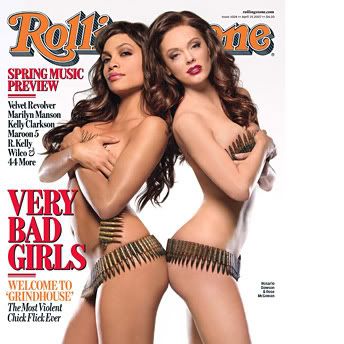











![Brotherhood" (2006) [TV-Series]](http://photos1.blogger.com/x/blogger2/1421/379621144723082/211/z/425926/gse_multipart33129.jpg)







No comments:
Post a Comment